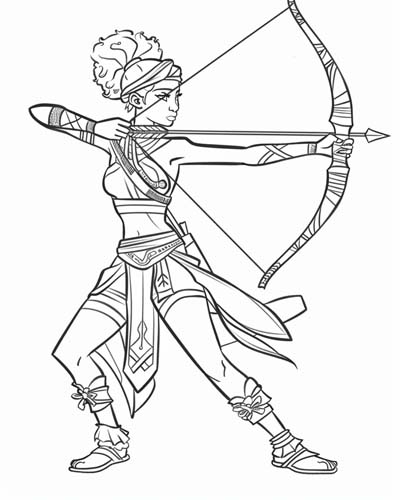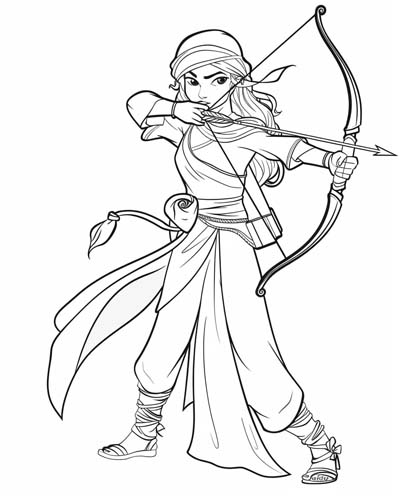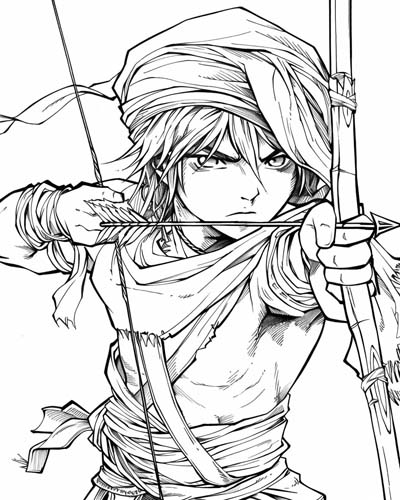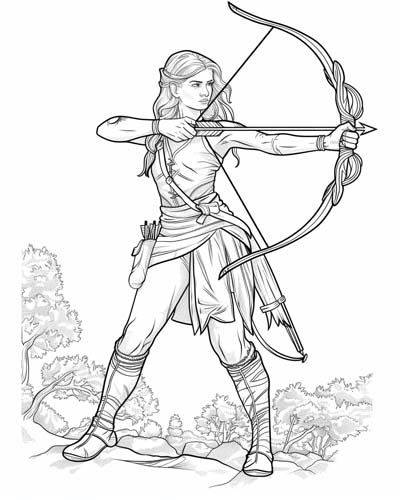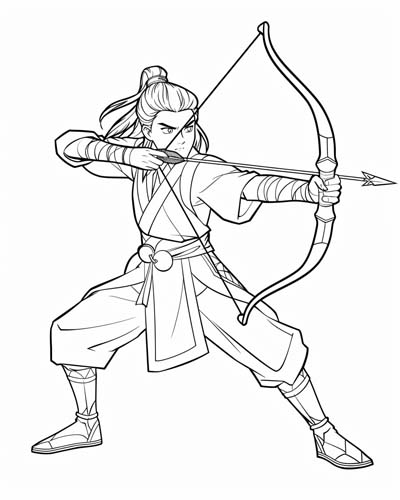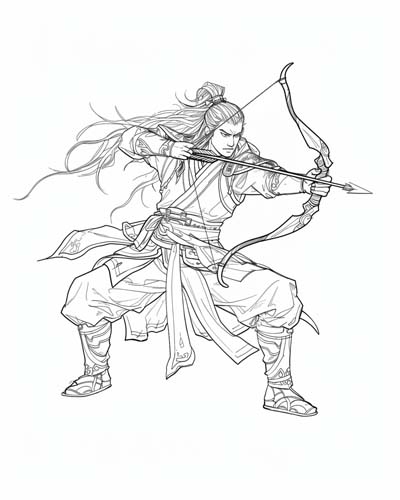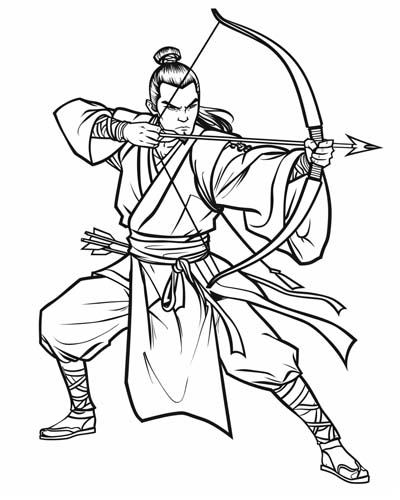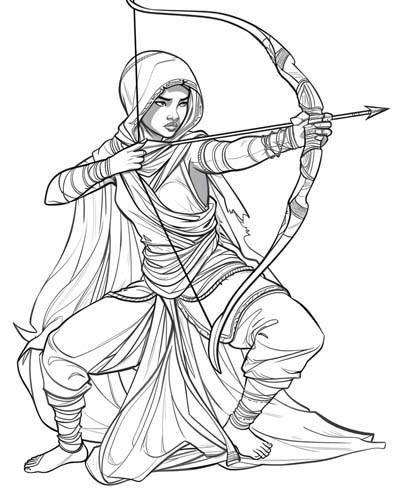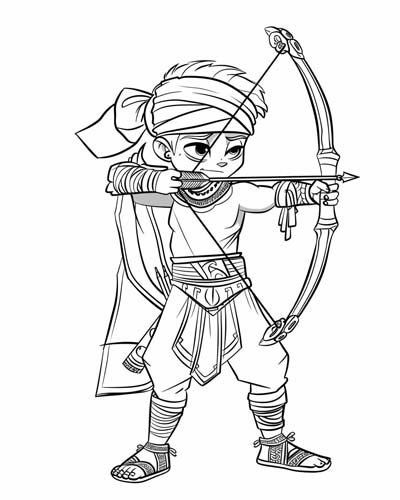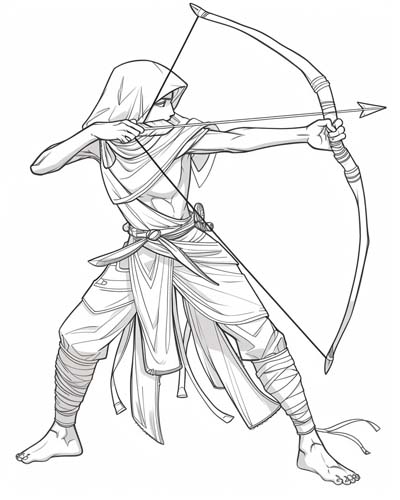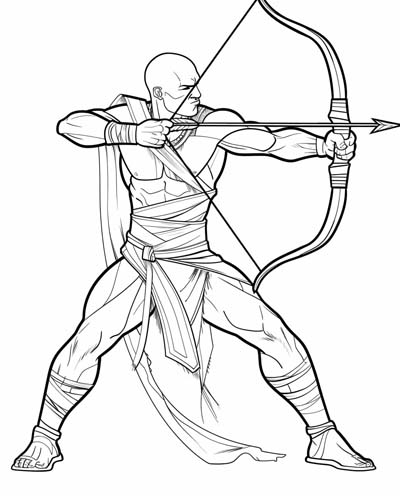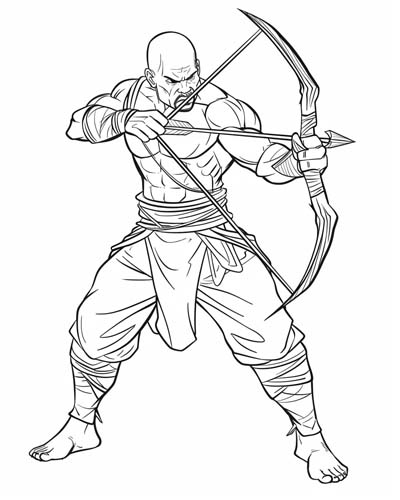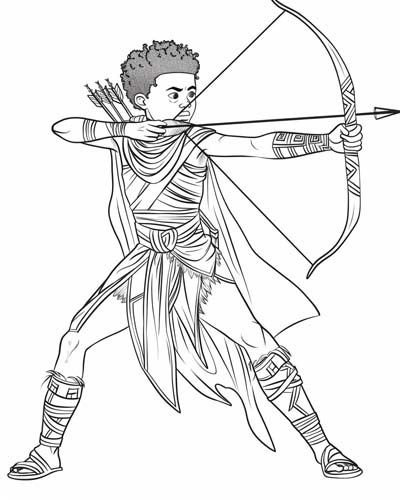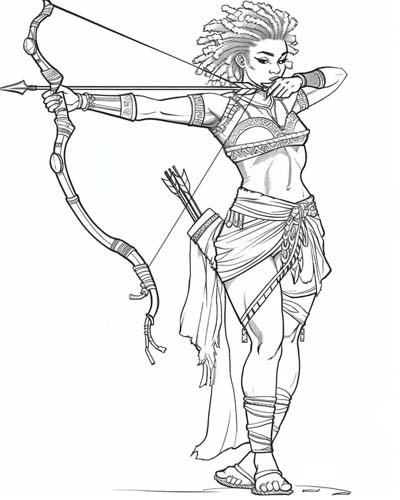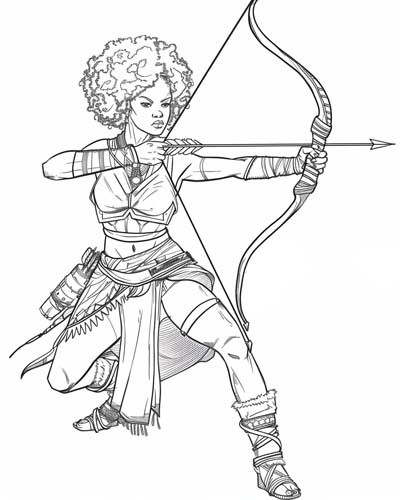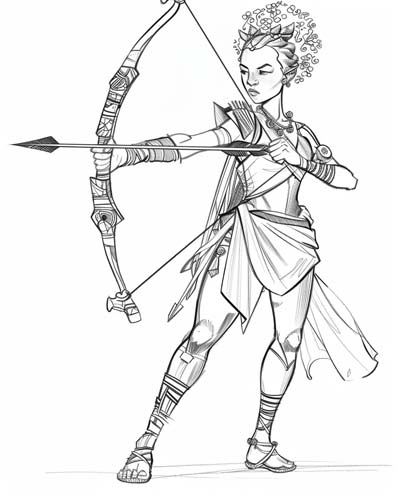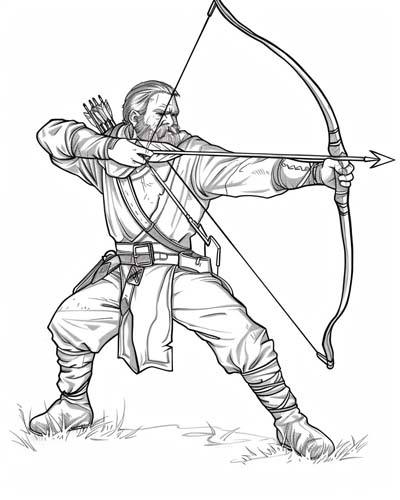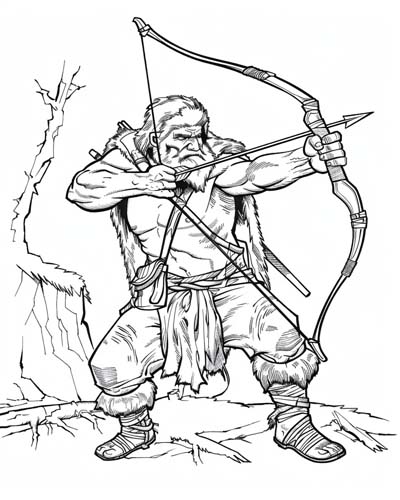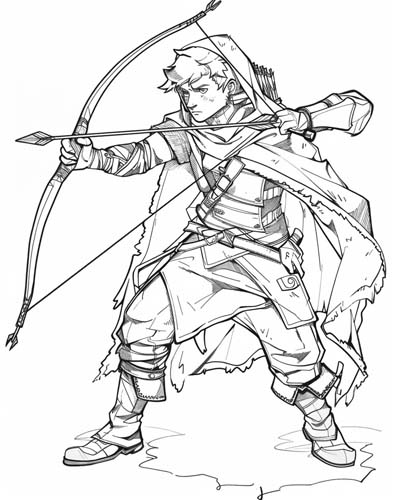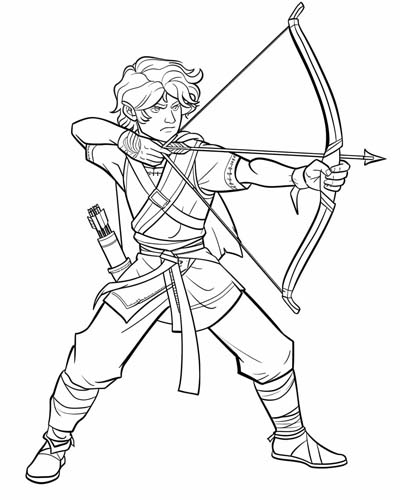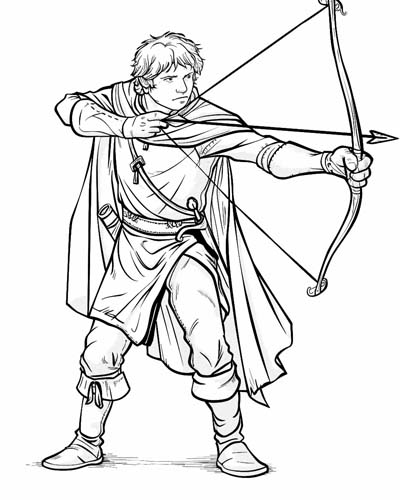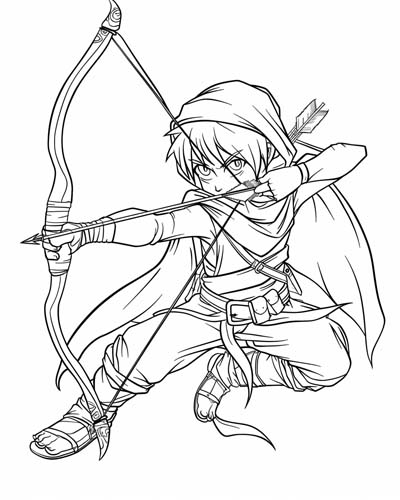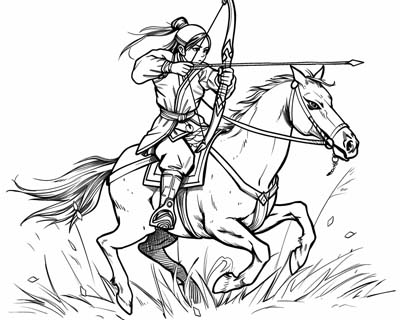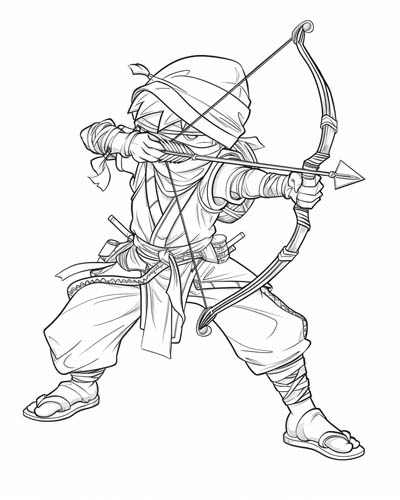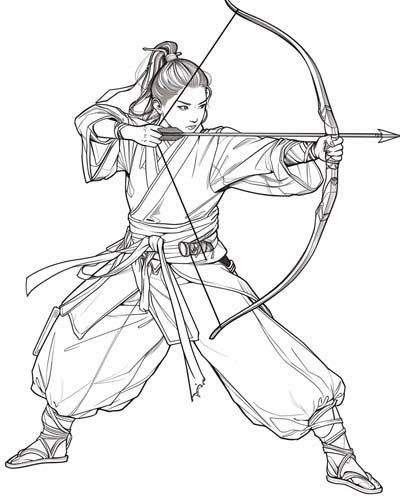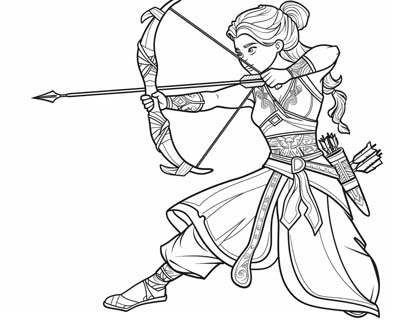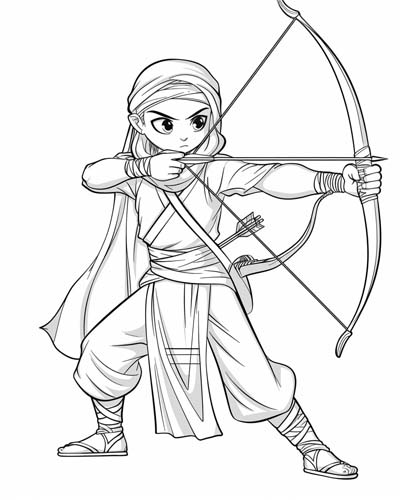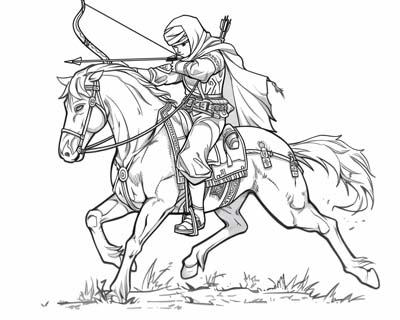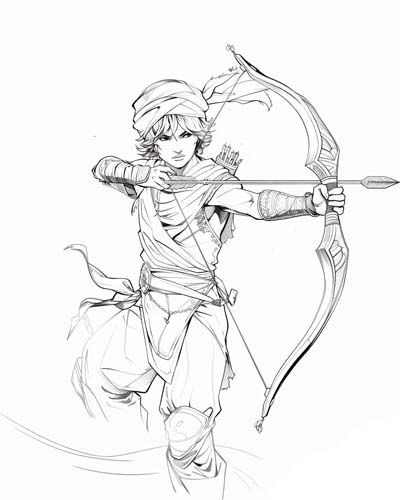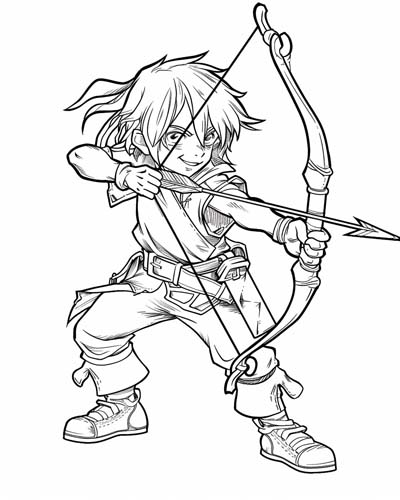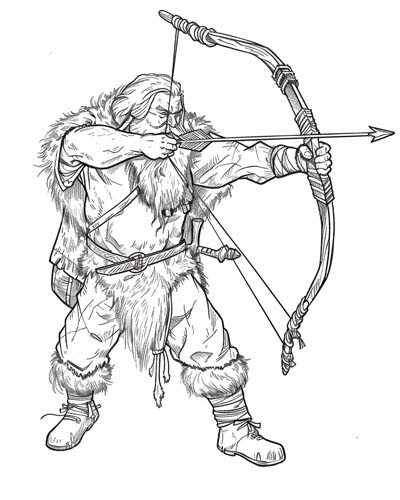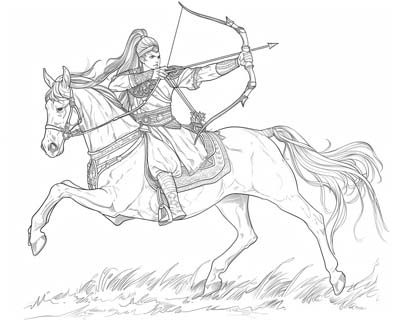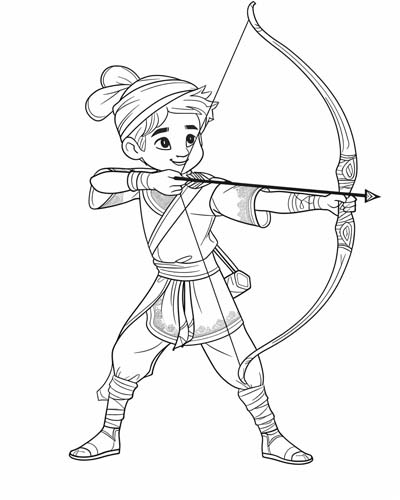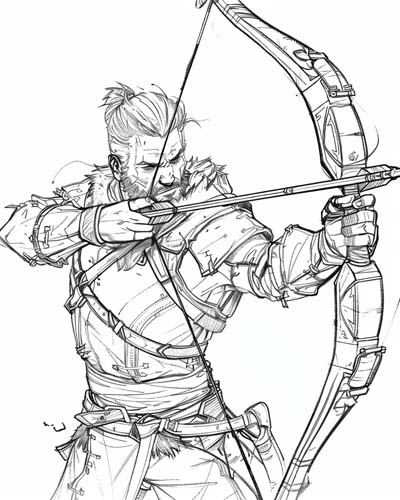Free, Printable Coloring Pages
Historical Archers Coloring Pages
Welcome to our Historical Archers coloring pages section.
This collection celebrates the archers who have played crucial roles throughout history, showcasing their skill and significance in various cultures and time periods. From ancient warriors who defended their lands with bows and arrows to medieval marksmen who fought in epic battles, archers have shaped the course of history. These pages capture the precision and discipline of archers, whether in ancient civilizations, medieval battles, or the martial traditions of the Far East, highlighting their contributions to warfare, hunting, and ceremonial practices.
The First Archer:
Ötzi the Iceman, also known simply as Ötzi, is one of the most well-preserved natural mummies of a man who lived around 3300 BCE. Discovered in the Ötztal Alps on the border between Austria and Italy in 1991, Ötzi has provided invaluable insights into the life and technology of Copper Age Europe.
Ötzi was found with a long, unfinished yew bow, about 1.82 meters (6 feet) long, indicating that he was skilled in bow-making. Alongside the bow were 14 arrows, only two of which were finished and ready for use, with flint arrowheads and fletching. The remaining arrows were in various stages of completion.
The Ahosi of Dahomey were remarkable women who served in the royal court and sometimes as elite warriors. Known for their strength, courage, and dedication, these women were integral to the kingdom's defense and governance. The Ahosi embodied the spirit of resilience and leadership, showcasing their ability to excel in both administrative and military roles, and leaving a legacy of powerful female influence in African history.
During the Ottoman period, archery was a revered skill, and there were even specialized schools and guilds for archers. Women of the Ottoman elite, including those in the imperial harem, Ayşe Hatun being a common imperial name, might have engaged in archery for sport and self-defense, although specific individual accounts are rare. Although not part of a formal group, these women often trained in archery for self-defense and as part of their noble upbringing.
The Bedouins, nomadic tribes of the Middle Eastern deserts, were renowned for their exceptional archery skills. Mastering the bow and arrow for both hunting and warfare, Bedouin archers utilized their profound knowledge of the harsh desert landscape to their advantage. Their ability to move swiftly and strike accurately exemplified their adaptability and survival instincts, making them formidable warriors and revered hunters.
Boudica, the warrior queen of the Iceni tribe in ancient Britain, is celebrated for her fierce resistance against Roman occupation. Though primarily known for her leadership and ferocity in battle, Boudica and her forces likely utilized archers in their campaigns, showcasing the importance of archery in ancient Celtic warfare.
Chinese Archers:
Chinese archers played a crucial role throughout the history of China, with several periods and groups standing out for their exceptional skills and impact on military tactics and strategies.
(Qin Dynasty of China, 221-206 BCE)
Qin archers were equipped with composite bows, which were advanced for their time, allowing for greater power and range. They played a critical role in the unification of China under Qin Shi Huang, using their skills in both siege warfare and open battles.
The inclusion of archers in the Terracotta Army underscores their importance in the military strategies that helped Qin Shi Huang consolidate his power and establish the first unified Chinese empire.
The Han Dynasty of China (206 BCE-220 CE)
The Han Dynasty saw significant developments in archery, both in military applications and in archery as a cultural and sporting practice. Han archers were integral to the dynasty's military successes, including defending against the Xiongnu and expanding the empire's borders.
Archery was also an important cultural practice during the Han Dynasty, considered one of the Six Arts of a Confucian gentleman. This dual role in both military and cultural contexts highlights the broader significance of archery in Han society.
The Ming Dynasty of China (1368-1644)
The Ming Dynasty is known for its significant military reforms and the establishment of a professional standing army, which included specialized units of archers. These units were essential in both the defense of the Great Wall and in campaigns against various nomadic tribes.
Detailed military manuals from the Ming period, such as the "Wubei Zhi" (Treatise on Military Preparedness), provide extensive information on archery techniques, training, and equipment. These manuals highlight the sophistication and discipline of Ming archers.
The Dahomey Amazons, or Agojie, were an elite all-female military regiment of the Kingdom of Dahomey, known for their fierce combat skills and unwavering loyalty. Trained to be exceptional archers, these warrior women played crucial roles in the kingdom's military campaigns. Their strength, discipline, and fearlessness in battle made them legendary, symbolizing the power and resilience of women warriors.
Dhanurveda archers, experts in the ancient Indian science of archery, were revered for their exceptional skills and disciplined training. Originating from the teachings of Dhanurveda, a classical Indian text that outlines the art of archery and warfare, these archers were masters of the bow and arrow. They played a pivotal role in the military strategies of the Maurya and Gupta Empires, where their precise and powerful archery was crucial in both defensive and offensive operations. Dhanurveda archers exemplified the blend of physical prowess, mental focus, and tactical knowledge, making them formidable warriors who left a lasting legacy in Indian martial history.
Egyptian Archers:
Egyptian archers were vital components of the ancient Egyptian military, renowned for their precision and strategic prowess. Skilled in the use of composite bows, they defended their lands and expanded their empire with remarkable effectiveness. From the foot soldiers to the charioteers, these archers demonstrated their expertise in both ranged combat and close-quarters engagements, contributing significantly to Egypt's dominance and legacy as a formidable ancient civilization.
Egyptian soldiers, including archers, were often described by their roles within the military. Terms such as 'meryt' (archers) and 'menfat' (troops) were used in Egyptian texts to refer to these soldiers in general terms. Archers were a key part of the 'menfat,' contributing to both offensive and defensive military strategies.
During different periods, Egypt employed various foreign mercenaries, including archers. The Sherden (from the Sea Peoples) and the Aamu (Asiatics) were among those who served as archers in the Egyptian army. While these terms denote their ethnic origins rather than a specific designation for archers, they highlight the diverse composition of Egyptian military forces.
Pharaohs such as Ramses II saw the potential of these formidable fighters and incorporated them into their forces. The Sherden were known for their exceptional prowess in hand-to-hand combat and archery, providing valuable support in both offensive and defensive operations.
Nubian archers, who were consistently employed by ancient Egyptian armies, were renowned for their exceptional skill and played significant roles in various historical periods. They had distinct roles and titles depending on the timeline and their specific duties. Renowned for their ability to hit distant targets with remarkable precision, these archers were highly valued as mercenaries and allies. Their expertise in archery played a crucial role in defending their homelands and contributing to the military successes of the great civilizations they served.
Ta-Seti Archers
- Timeline: Predynastic to Early Dynastic Periods (circa 3500–2686 BCE)
- Role: The term "Ta-Seti" refers to the land of the bow, a region in Nubia known for its archers. Ta-Seti archers were among the earliest recorded Nubian archers and were famed for their exceptional skill with the bow.
- Notable Features: These archers were often depicted in Egyptian art and inscriptions, highlighting their prominence and expertise.
Medjay Archers
- Timeline: Middle Kingdom to New Kingdom (circa 2055–1069 BCE)
- Role: The Medjay were originally a Nubian tribe that became an elite paramilitary force in ancient Egypt. They served as scouts, desert police, and soldiers, including skilled archers. Medjay archers were highly valued for their ability to navigate and fight in harsh desert conditions.
- Notable Features: Known for their loyalty and effectiveness, Medjay archers were crucial in maintaining order and defending Egypt's borders.
Kushite Archers
- Timeline: Kingdom of Kush (circa 1070 BCE–350 CE)
- Role: During the Kingdom of Kush, which ruled Nubia and even conquered Egypt during the 25th Dynasty, archers were a critical component of the military. Kushite archers were instrumental in battles and known for their precision and range.
- Notable Features: They often used composite bows and were part of both offensive and defensive operations in Kushite and Egyptian territories.
Female troops, particularly in the Kingdom of Kush, also played significant roles, demonstrating the inclusivity and adaptability of Nubian military practices.
Female Medjay
- Timeline: Middle Kingdom to New Kingdom (circa 2055–1069 BCE)
- Role: While most Medjay warriors were male, there is evidence that women could also serve in some capacity, potentially including roles as archers. This is inferred from various artistic depictions and inscriptions that sometimes include female figures in military contexts.
- Notable Features: Female Medjay would have undergone similar training and responsibilities as their male counterparts, highlighting the flexibility of Nubian military roles.
Candace's Warriors
- Timeline: Meroitic Period (circa 300 BCE–350 CE)
- Role: The title "Candace" (or "Kandake") referred to the queens or queen mothers of the Kingdom of Kush. Historical records and legends suggest that some Candaces led troops into battle and that women served in the Kushite military, including as archers.
- Notable Features: The involvement of women in military roles, particularly under the leadership of powerful queens, indicates a significant level of gender inclusivity in the Kushite military structure.
Role of Women in Nubian Society:
- Nubian society, especially during the Kingdom of Kush, was known for its relatively high status and influence of women. Queens, queen mothers (known as Kandakes or Candaces), and noblewomen held significant power and often played active roles in political and military affairs.
Martial Training:
- Given the importance of archery in Nubian military and hunting practices, it is plausible that noblewomen, particularly those involved in leadership roles, would have been trained in archery. This training could serve both practical purposes and as a demonstration of their status and capabilities.
Following the Welsh influence, English longbowmen became a dominant force in European warfare from the 13th to the 16th centuries. Trained from a young age to use the powerful longbow, these archers could shoot accurately at great distances. Their devastating volleys were instrumental in many of England's military victories during the Hundred Years' War and other conflicts.
Yeomanry: The yeomen were a class of English society who were often skilled archers and made up a significant portion of the English longbowmen.
Retinue Archers: These were archers who served as part of the personal retinue of a noble or a knight.
Germanic: In many medieval German towns, marksmen or archery guilds (Schützenvereine) were established. These guilds promoted archery as both a military skill and a competitive sport. They played a crucial role in local defense and festivities.
Schützen: The term "Schützen" (meaning "marksmen" or "shooters") was commonly used to refer to archers and later riflemen. These groups were organized into guilds and played significant roles in both military and civic life.
Hungarian archers, especially during the time of the Hungarian Kingdom and the Huns, were known for their skilled use of the bow. Their composite bows, influenced by the designs of steppe nomads, were powerful and effective in both mounted and foot combat. Hungarian archers played significant roles in defending their territories against various invasions and in expanding their influence in Central Europe.
Irish archers were a significant part of medieval Irish warfare, known for their dexterity and effectiveness in battle. They utilized both longbows and shorter, more maneuverable bows suited to the varied terrain of Ireland. These archers were often light-footed, capable of moving quickly through forests and rough landscapes, making them formidable in guerrilla warfare tactics.
The term 'Kern' (or 'Ceithern' in Irish) was used to describe light infantry soldiers in medieval Ireland, who often included skilled archers. These warriors were typically drawn from the lower classes and were known for their mobility, agility, and versatility in battle. Kerns were essential in the guerrilla warfare tactics employed by Irish forces against invading armies, using their knowledge of the terrain to great advantage.
Medieval archers were the backbone of many armies, known for their vital role in battles and sieges across Europe. Armed with longbows or crossbows, these archers demonstrated remarkable precision and endurance. Their skills could turn the tide of battle, peppering enemies from a distance and providing critical support to infantry and cavalry. Their dedication to their craft and the pivotal role they played in medieval warfare highlight the enduring significance of archery throughout history.
Medieval bandits roamed the forests and countryside, using their archery skills for survival and rebellion. These outlaws, often romanticized in folklore, lived on the fringes of society, stealing from the rich and resisting oppressive authorities. Their ability to strike swiftly and disappear into the wild made them both feared and admired, embodying the spirit of defiance and the quest for survival in a difficult age.
Mongolian archers on horseback were among the most formidable warriors in history. Under the leadership of Genghis Khan, they created one of the largest empires the world has ever seen. These archers mastered the art of shooting from horseback, capable of releasing arrows with deadly accuracy while galloping at full speed. Their composite bows, adapted for the harsh conditions of the steppes, were powerful and precise, making Mongolian horse archers a dominant force in their conquests.
While ninjas are primarily known for their stealth and espionage, some historical accounts and legends suggest they also employed archery as part of their diverse arsenal. Ninja archers would have used their bows for silent attacks and long-range assassinations, blending their archery skills with their trademark stealth and agility. Whether scaling walls or hiding in the shadows, the ninja archer symbolizes the versatility and resourcefulness of these mysterious warriors.
Onna Bugeisha were female warriors of the Japanese samurai class, trained in the use of weapons including the bow. These formidable women demonstrated their prowess in archery, defending their homes and honor with remarkable skill and bravery. As both protectors and warriors, Onna Bugeisha archers symbolize the strength and resilience of women in a traditionally male-dominated society, highlighting their critical role in Japan's martial history.
The Ottoman Empire boasted highly skilled archers who were integral to their military success. Ottoman archers were renowned for their use of the composite bow, which was both powerful and highly efficient for mounted and foot archery. The Ottomans developed a sophisticated archery tradition, with dedicated training schools called 'tekke' where archers perfected their craft.
These archers played a crucial role in the rapid expansion of the Ottoman Empire, participating in numerous battles and sieges across Europe, Asia, and Africa. They were especially famous for their mobility and accuracy, contributing significantly to the effectiveness of the Ottoman military.
One of the most famous groups within the Ottoman archery tradition were the Janissaries, an elite infantry unit that included skilled archers. These soldiers were rigorously trained and highly disciplined, making them one of the most formidable military forces of their time.
Parthian archers were renowned for their innovative and highly effective combat tactic known as the 'Parthian shot.' These horse archers would feign retreat, only to turn and shoot accurately at pursuing enemies while riding away. This technique, combined with their exceptional horsemanship and powerful composite bows, made Parthian archers formidable opponents in ancient warfare. Their legacy endures as a testament to their strategic ingenuity and martial prowess.
Persian archers were a crucial component of the ancient Persian military, renowned for their skill, discipline, and versatility. Armed with powerful composite bows, they could unleash a deadly rain of arrows upon their enemies. Persian archers played significant roles in the conquests of the Achaemenid Empire, contributing to its expansion and dominance. Their expertise in both foot and mounted archery, combined with strategic precision, underscores their importance in one of history's greatest empires.
Pirate archers, though less common than swordsmen and gunners, brought a unique skill set to the high seas. Utilizing their bows for silent, long-range attacks, these archers could strike from the rigging or the deck, taking down opponents with precision. Their ability to blend stealth with deadly accuracy made them formidable foes, embodying the adventurous and ruthless spirit of piracy. These skilled marksmen added an element of surprise and tactical advantage to pirate raids and skirmishes.
Samurai archers, or 'kyujutsu' practitioners, held a revered place in feudal Japan. Mastering the yumi, a long asymmetrical bow, these warriors showcased exceptional skill and discipline. Archery was considered an essential martial art for samurai, combining physical prowess with a deep philosophical practice. Samurai archers were integral to both warfare and ceremonial events, embodying the blend of martial skill, honor, and tradition that defines the samurai ethos. Their precise and powerful archery, whether on foot or horseback, remains a symbol of their enduring legacy.
Scottish archers - Scottish archers played a significant role in the military history of Scotland, particularly during the medieval period. Their skills in archery were crucial in various conflicts, including the Wars of Scottish Independence against England. Archers were often integrated into larger clan-based military forces. Each clan would have its own contingent of warriors, including those skilled in archery.
"Gaisgeach" is a Gaelic term for a warrior or hero. While not specific to archers, this term would encompass all types of warriors, including those skilled in archery. It reflects the broader warrior tradition in Gaelic culture.
"Gàidheil": While this term broadly refers to the Gaelic-speaking people, it was also used to describe the Highland warriors, many of whom were skilled archers.
Scythian archers - The Scythians were a group of nomadic tribes known for their exceptional skills in archery and horsemanship. They lived in the region known as Scythia, which covered parts of modern-day Ukraine, Russia, and Central Asia, from around the 7th century BCE to the 3rd century BCE.
Scythian archers employed guerrilla warfare tactics, using their mobility to harass and outmaneuver larger, less agile enemy forces. Their ability to shoot accurately from horseback allowed them to engage enemies from a distance and retreat quickly before counterattacks could be launched. This tactic, known today as the 'Parthian shot,' was later adopted by other cultures and became synonymous with mounted archery excellence.
Turkish archers, particularly during the time of the Seljuk and Ottoman Empires, were known for their exceptional skill and the use of powerful composite bows. Their expertise was crucial in many significant battles and sieges, contributing to the expansion and dominance of the Ottoman Empire.
Viking archers were integral to Viking warfare, providing ranged support during raids and battles. Their bows, often made from yew, ash, or elm, allowed them to strike from a distance before engaging in hand-to-hand combat. Archers were particularly useful during sieges, where they could target enemies from behind fortifications.
Bondi: Free men who were part of the Viking levies and could be called upon for military service, including archery.
Welsh archers were renowned for their exceptional skill and played a pivotal role in medieval warfare. The longbow, often made from yew, was a staple weapon for the Welsh, who developed advanced techniques for its use. Their ability to shoot powerful, accurate volleys made them formidable opponents in battles. The effectiveness of Welsh archers was notably recognized during the wars between England and Wales, and their prowess influenced the English military, leading to the widespread adoption of the longbow in English armies.
Ymarchogion: This term means "knights" in Welsh, but it was sometimes used to refer to skilled longbowmen.

